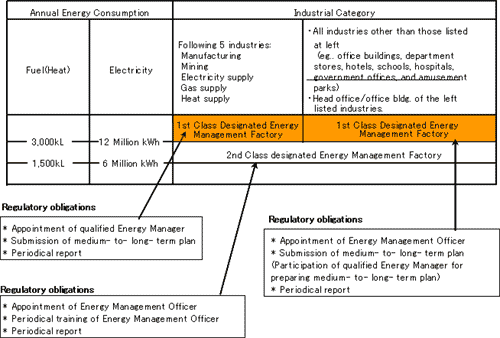11.Category
of designated energy management factory

| AEEC Home | Training Index | Index | Top | Previous | Next |
| METI/ECCJ/AOTS Training Program | Indonesia |
|
10-1 Promotion
of energy conservation measures (1) |
| a) Introduction
and promotion of energy conservation
equipment and systems For promoting energy conservation equipment, investment in industry and commerce, loan programs and tax reduction have been established (low interest loans by the Japan Development Bank andSmaller Business Finance Corporation and a tax system for promoting investment to reform energy supply and demand structure) by the Energy Conservation Assistance Law. b) Acceleration of development and practical application of energy conservation technologies. To technologically ensure the practice of energy conservation in future, the R&D of technologies concerned with energy conservation has been promoted under the cooperation among industries,the government and academy. c) Formulation and application of guidelines based on the Energy Conservation Law a. Industrial sector: Guidelines for factories, etc. b. Transportation sector: Fuel consumption standards for automobiles and Fuel consumption standards for trucks. c. Commercial and residential sector:
|
|
10-2 Promotion
of energy conservation measures (2) |
| d) Enhancing
people's awareness of energy conservation
by publicity activities. a. Being thoroughly informed of various measures by the Council for Promotion of Energy and Resources Conservation Measures, such as "energy conservation in summer and winter." b. Preparing and distributing posters and pamphlets, holding symposiums and offering information through mass media. e) Active promotion of the energy conservation labeling system a. In June 1995, Japan and the U.S.A. agreed to unify the standard and the indicating system of the International Energy Star Program which is an energy conservation standard for office automation equipment from personal computers and the program was enforced on October 1, 1995. |
|
11.Category
of designated energy management factory |
 |
|
12-1 Energy
Audit Program (1) |
|
(1) Energy
audit for small and midsize factories Energy audit service for small and midsize factories took place in 1975 and approximately 5,600 cases of energy audit service have since been conducted in the factories around Japan. a) Target factories: A firm whose capital is less than 100 million yen or whose total number of employees is less than 300. b) Cost:Free of charge c) Number of auditors and auditing period: Number of experts: 1-2; Period: 1-2 days d) Audit:
|
| 13/14 Next |
| AEEC Home | Training Index | Index | Top | Previous | Next |